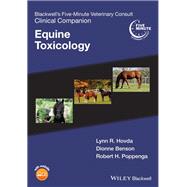A clinical quick-reference guide to managing toxicants in horses
Blackwell’s Five-Minute Veterinary Consult Clinical Companion: Equine Toxicology provides crucial information for managing toxicants in horses in a quick-reference format. The book begins with foundational information on clinical toxicology, including emergency management, antidotes, sample analysis, and necropsy. It then discusses specific toxicant categories and toxicants of concern, organized alphabetically for fast access in emergency situations.
The identically formatted topics offer key information relevant to managing toxicants in horses, plus clinical photographs depicting plants and drugs to help clinicians and students identify toxicants. A companion website presents the figures from the book for download in PowerPoint.
This book is the ideal clinical resource for busy practitioners seeking immediate access to life-saving information in time-sensitive emergencies. It places all the information the reader needs to manage toxicants in horses at their fingertips, with full color images and concise bullet points.
Blackwell’s Five-Minute Veterinary Consult Clinical Companion: Equine Toxicology features:
- A thorough introduction to emergency management of the poisoned equine patient, as well as general principles of toxicants, antidotes, lab sample analysis, and necropsy analysis
- An exploration of specific toxins and toxicants, including illicit and pharmaceutical drugs, envenomations, insecticides, herbicides, and farm chemicals
- Practical discussions of metal, mycotoxin, rodenticide, and plant toxicology in horses
- In-depth discussion of intoxication by poisonous trees and miscellaneous toxins, like carbon monoxide, nitrates, nitrites, salt, smoke, and tropical materials
Blackwell’s Five-Minute Veterinary Consult Clinical Companion: Equine Toxicology is an indispensable reference for veterinary clinicians and students dealing with equine medicine, as well as for anyone seeking concise and comprehensive information about equine toxicology.









